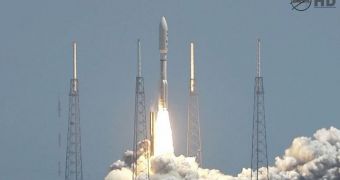Freshly launched from the Cape Canaveral Air Force Station (CCAFS), in Florida, the Juno spacecraft is carrying the first JEDI to Jupiter. The mission will arrive at the largest planet in our solar system in July 2016, when it is scheduled to begin a 1-year observations campaign.
Juno carries a variety of instruments as part of its scientific suite, including the Jupiter Energetic-particle Detector Instrument (JEDI), the first device of its type to be destined for orbital insertion around Jupiter.
The instrument was developed by experts at the Johns Hopkins University (JHU) Applied Physics Laboratory (APL) and is designed to investigate the magnetic field that the gas giant is producing. Jupiter's magnetic field is the second-most intense in the solar system, after the Sun's.
The device can measure the amount of energetic particles that flow through the Jovian atmosphere, as well as the number of particles that get trapped in the planet's surroundings. In other words, JEDI will look at how solar particles interact with the planet's magnetosphere.
Jupiter's auroras (its bright northern and southern lights) are caused by energetic particles flowing along magnetic field lines above the surface of Jupiter. On the gas giant, auroras are much brighter than they are here on Earth, despite the fact that our planet is closest to the Sun.
“Because the processes operating within Jupiter's space environment are so powerful, we must study the planet to make the connection between such Earth-space phenomena as auroras, radiation belts and magnetic field dynamics, and similar astrophysical processes elsewhere in the Universe,” Barry Mauk says.
The APL scientist holds an appointment as the lead investigator of the JEDI instrument. The principal investigator of the Juno mission is Southwest Research Institute (SwRI) expert Scott Bolton.
“JEDI's sensors will be trained on the higher-energy particles that help to generate Jupiter's aurora, that heat and ionize Jupiter's upper atmosphere, and that offer clues to the structure of Jupiter's near-planet space environment,” Mauk adds, quoted by SpaceRef.
“We really want to know what happens in the aurora that causes these particles to accelerate to such high energies, and Juno will be the first spacecraft to fly within the region where this acceleration actually takes place,” he goes on to say.
The space probe launched yesterday, August 4, aboard a United Launch Alliance (ULA) Atlas V delivery system. The launch took place at 12:25 pm EDT (1625 GMT), a short while after the mission's 22-day launch window opened.
Juno is the first solar-powered spacecraft to be sent to Jupiter and it carries some of the most advanced space instruments ever deployed on an orbiter.

 14 DAY TRIAL //
14 DAY TRIAL //